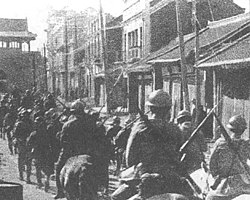Manchurian Incident
| Mukden Incident | |||||||
|---|---|---|---|---|---|---|---|
| Part of the Japanese invasion of Manchuria | |||||||
 Japanese troops entering Shenyang during the Mukden Incident |
|||||||
|
|||||||
| Belligerents | |||||||
|
|
|
||||||
| Commanders and leaders | |||||||
| Strength | |||||||
| 160,000 | 30,000–66,000 | ||||||
| Casualties and losses | |||||||
| ? | ? | ||||||
Japanese victory
The Mukden Incident, or Manchurian Incident, was a staged event engineered by Japanese military personnel as a pretext for the Japanese invasion in 1931 of northeastern China, known as Manchuria.
On September 18, 1931, Lt. Suemori Kawamoto detonated a small quantity of dynamite close to a railway line owned by Japan's South Manchuria Railway near Mukden (now Shenyang). The explosion was so weak that it failed to destroy the track and a train passed over it minutes later, but the Imperial Japanese Army accused Chinese dissidents of the act and responded with a full invasion that led to the occupation of Manchuria, in which Japan established its puppet state of Manchukuo six months later. The ruse of war was soon exposed by the Lytton Report of 1932, leading Japan to diplomatic isolation and its March 1933 withdrawal from the League of Nations.
The bombing act is known as the "Liutiaohu Incident" (simplified Chinese: 柳条湖事变; traditional Chinese: 柳條湖事變; pinyin: Liǔtiáohú Shìbiàn, Japanese: 柳条湖事件, Ryūjōko-jiken), and the entire episode of events is known in Japan as the "Manchurian Incident" (Kyūjitai: 滿洲事變, Shinjitai: 満州事変, Manshū-jihen) and in China as the "September 18 Incident"(simplified Chinese: 九一八事变; traditional Chinese: 九一八事變; pinyin: Jiǔyībā Shìbiàn).
...
Wikipedia
